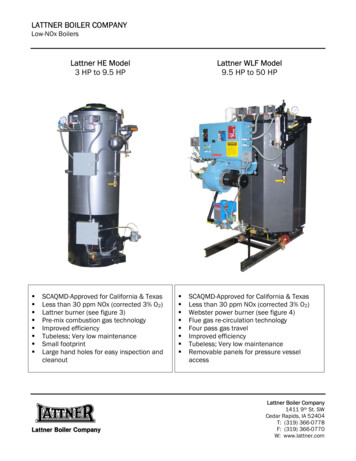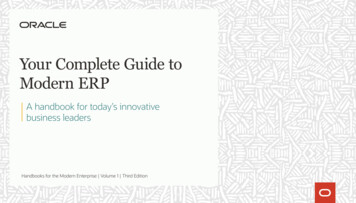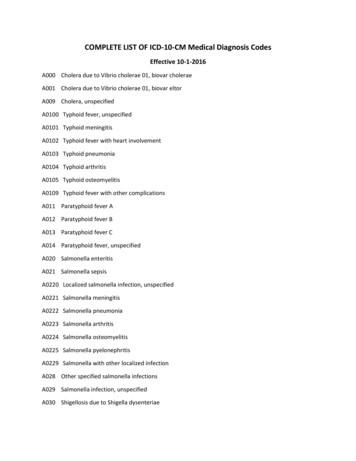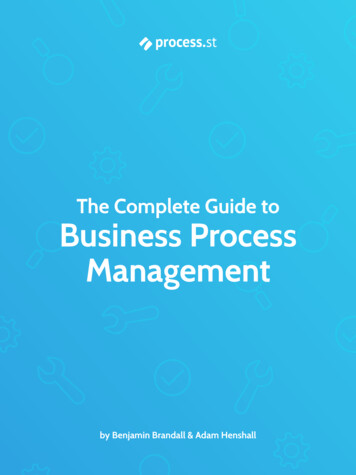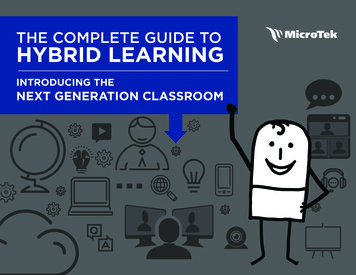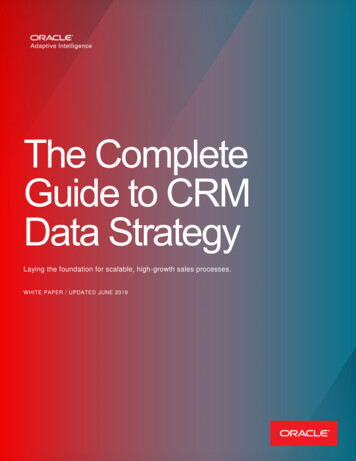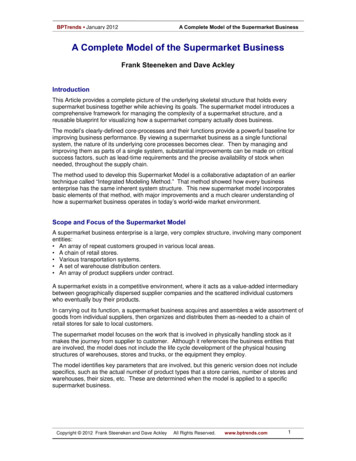
Transcription
BPTrends January 2012A Complete Model of the Supermarket BusinessA Complete Model of the Supermarket BusinessFrank Steeneken and Dave AckleyIntroductionThis Article provides a complete picture of the underlying skeletal structure that holds everysupermarket business together while achieving its goals. The supermarket model introduces acomprehensive framework for managing the complexity of a supermarket structure, and areusable blueprint for visualizing how a supermarket company actually does business.The model’s clearly-defined core-processes and their functions provide a powerful baseline forimproving business performance. By viewing a supermarket business as a single functionalsystem, the nature of its underlying core processes becomes clear. Then by managing andimproving them as parts of a single system, substantial improvements can be made on criticalsuccess factors, such as lead-time requirements and the precise availability of stock whenneeded, throughout the supply chain.The method used to develop this Supermarket Model is a collaborative adaptation of an earliertechnique called “Integrated Modeling Method.” That method showed how every businessenterprise has the same inherent system structure. This new supermarket model incorporatesbasic elements of that method, with major improvements and a much clearer understanding ofhow a supermarket business operates in today’s world-wide market environment.Scope and Focus of the Supermarket ModelA supermarket business enterprise is a large, very complex structure, involving many componententities: An array of repeat customers grouped in various local areas. A chain of retail stores. Various transportation systems. A set of warehouse distribution centers. An array of product suppliers under contract.A supermarket exists in a competitive environment, where it acts as a value-added intermediarybetween geographically dispersed supplier companies and the scattered individual customerswho eventually buy their products.In carrying out its function, a supermarket business acquires and assembles a wide assortment ofgoods from individual suppliers, then organizes and distributes them as-needed to a chain ofretail stores for sale to local customers.The supermarket model focuses on the work that is involved in physically handling stock as itmakes the journey from supplier to customer. Although it references the business entities thatare involved, the model does not include the life cycle development of the physical housingstructures of warehouses, stores and trucks, or the equipment they employ.The model identifies key parameters that are involved, but this generic version does not includespecifics, such as the actual number of product types that a store carries, number of stores andwarehouses, their sizes, etc. These are determined when the model is applied to a specificsupermarket business.Copyright 2012 Frank Steeneken and Dave AckleyAll Rights Reserved.www.bptrends.com1
BPTrends January 2012A Complete Model of the Supermarket BusinessWhat is a Business Enterprise?As shown in Figure 1, a typical business enterprise exists in a competitive marketplace, where itacquires resources from its supplier market, adds value by transforming them into products orservices, and sells the results to its customer Market.Figure 1: Business EnterpriseWhat is a Supermarket?A supermarket is a business enterprise that provides a service. It does not produce a physicalproduct of its own in the usual sense. Instead, it adds value by acquiring existing products fromremotely-located suppliers, assembling them in regional warehouses, distributing them to localstores, and finally selling the supplier’s products to local customers. Figure 2 shows the generalflow of stock from suppliers, through the supermarket business to local customers.Figure 2: Supermarket BusinessA supermarket’s customers are primarily local residents and small businesses that periodicallyneed to replenish their stock of household products. A supermarket’s suppliers are primarilyproducers of household products that are established far from the locations of their finalcustomers. In effect, the supermarket provides a virtual marketplace that brings remote supplierstogether with local customers. Given this arrangement, the supermarket “product” is its supplychain.Copyright 2012 Frank Steeneken and Dave AckleyAll Rights Reserved.www.bptrends.com2
BPTrends January 2012A Complete Model of the Supermarket BusinessHow is the Supermarket Model Structured?The model portrays a supermarket as a functional system for doing business. As a system, thesequence of work performed in bringing products from remote suppliers to local customersinvolves certain discrete business entities. Each of these entities provides a critical link in thesupermarket supply chain. Figure 3 identifies these business entities as subsystem layers of themodel, and defines the functional activities they perform.Figure 3: Functional ActivitiesThis sequence of business entities provides an initial breakdown to define the structure ofsupermarket subsystem layers. To complete the overall structure of the supermarket model, thestructure of subsystem layers is overlaid with a sequence of four core processes, which representthe life-cycle of a supermarket business. Figure 4 shows the four core processes in a timesequence, overlaid on the previously-described subsystem layers.Figure 4: Core ProcessesCopyright 2012 Frank Steeneken and Dave AckleyAll Rights Reserved.www.bptrends.com3
BPTrends January 2012A Complete Model of the Supermarket BusinessThe core process sequence begins by defining the business concept in terms of a detailed set ofsystem requirements. This definition of requirements is then transformed into a tangible design,followed by constructing of the structures, procedures and contractual agreements that make upthe business. The final core process shows how the resulting structures are employed toprovision the actual supermarket service. To fulfill the original business concept, the four coreprocesses are implemented over time. This four-stage development sequence comprises the lifecycle of the supermarket’s business enterprise product.Developing Details of the Supermarket Model StructureA more detailed subsystem structure is required as a basis for defining the core processstructures. The first task is to translate the Functional Activities to be Performed (from Figure 3)into the sequence of Basic Functional Steps that bring product stock from remote suppliers tolocal customers. As shown in Figure 5, these steps describe the essential supply chain of thesupermarket business.Figure 5: Supply ChainAs the blue Basic Functional Steps column shows, the physical properties of the supplier Stockremain unchanged throughout the sequence of subprocess steps. The Stock goes through asequence of actions that affect only its assigned properties, such as its location, accessibility,visibility, and purchase price.Copyright 2012 Frank Steeneken and Dave AckleyAll Rights Reserved.www.bptrends.com4
BPTrends January 2012A Complete Model of the Supermarket BusinessThe next task is to interpret the Basic Functional Steps as business subsystems, which portraythe supply chain in terms of business structural requirements. In Figure 6, the terminology shiftsfrom action steps to the state of supplier stock at each subsystem level. For each step in thesupply chain, this indicates which business entity owns or is responsible for the stock, its physicallocation, and how it is being accessed.Figure 6: SubsystemsCopyright 2012 Frank Steeneken and Dave AckleyAll Rights Reserved.www.bptrends.com5
BPTrends January 2012A Complete Model of the Supermarket BusinessThe more detailed subsystem structure of Figure 6 provides the foundation needed to identifydetails of the four core processes and how they are to be performed. By directly connecting theBasic Functional Steps to the structure of subsystem layers, it forces the breakdown of coreprocess work to coincide with the basic functional steps of the supply chain.When the detailed subsystems and core processes are combined, they produce a grid-likeframework. Within this framework, each subsystem/core process intersection is interpreted as aBusiness Function to be managed and performed. In terms of work to be performed, the resultingarray of subsystem/core process intersections displays the entire set of business functions of thesupermarket business enterprise.Using this subsystem structure, each of the four core processes will be added sequentially to thesubsystem structure to create a diagram of the supermarket model. As each core process isadded, a description is provided to show how each of the new business functions is to beperformed. Figure 7 illustrates how the business functions are to be identified and described:Figure 7: Business FunctionIn the Supermarket Model diagrams that follow, the first three core processes (Defining,Designing, and Constructing) show downward arrows between their functions. This is to indicatethat work to develop the supermarket business concept is essentially customer-market driven.The fourth core process (Provisioning) shows upward arrows to portray the flow of stock fromsupplier to customer.The purpose of this supermarket model is to clearly portray how the work performed in asupermarket business is structured, apart from the way it is managed and controlled. To providethis clarity, feedback loops and control systems are not shown on these diagrams.Copyright 2012 Frank Steeneken and Dave AckleyAll Rights Reserved.www.bptrends.com6
BPTrends January 2012A Complete Model of the Supermarket BusinessImplementing the Defining Core ProcessFigure 8 provides a breakdown of the Defining Core Process into business functions that matchthe supply chain sequence of functional steps from Figure 7. Each business function is defined interms of its requirements. Collectively, this column of descriptions defines the original businessconcept as a requirements specification for what is to be designed, constructed and provisioned.Figure 8: Defining Core ProcessCopyright 2012 Frank Steeneken and Dave AckleyAll Rights Reserved.www.bptrends.com7
BPTrends January 2012A Complete Model of the Supermarket BusinessImplementing the Designing Core ProcessIn Figure 9, the previously-defined requirements specifications are translated into acomprehensive structural design framework that can be constructed and provisioned. Thehorizontal arrows between subsystem functions indicate their sequence in time.Figure 9: Designing Core ProcessCopyright 2012 Frank Steeneken and Dave AckleyAll Rights Reserved.www.bptrends.com8
BPTrends January 2012A Complete Model of the Supermarket BusinessImplementing the Constructing Core ProcessBased on the previous Figure 9 comprehensive structural design framework, Figure 10 showshow the individual subsystem units are constructed to carry out their role within the integratedsupplier-to-customer work-flow sequence.Figure 10: Constructing Core ProcessCopyright 2012 Frank Steeneken and Dave AckleyAll Rights Reserved.www.bptrends.com9
BPTrends January 2012A Complete Model of the Supermarket BusinessImplementing the Provisioning Core ProcessOnce constructed, the original Business Concept can be put into action by provisioning thesupplier stock as needed to fulfill the customer-driven store shelf-stock requirements. Note thatIn Figure 11 the arrows between the provisioning business functions proceed upward. This isbecause the provisioning core process column portrays the physical flow of stock, from suppliersto customers.Figure 11: Provisioning Core ProcessCopyright 2012 Frank Steeneken and Dave AckleyAll Rights Reserved.www.bptrends.com10
BPTrends January 2012A Complete Model of the Supermarket BusinessThe Addition of a Supporting Core ProcessThe four core processes (defining, designing, constructing, and provisioning) embody the basicproduct life-cycle of a supermarket business. Figure 12 shows how a partial fifth core process isadded to portray how each store fulfills its purchase-warranty obligations to its customers.Most customer returns of purchased stock are accommodated at the store by replacing thereturned stock with a new item from existing store stock. In practice, stores often order a smallquantity of additional store-stock to cover stock returns and stock-theft. In rare cases, whereextra store stock is not available (e.g., shortages or very large stock items), the supportingtransaction will be delayed until the new stock-item arrives at the store.Figure 12: Supporting Core ProcessCopyright 2012 Frank Steeneken and Dave AckleyAll Rights Reserved.www.bptrends.com11
BPTrends January 2012A Complete Model of the Supermarket BusinessApplication of the Supermarket ModelThe supermarket model can be applied to all types and sizes of supermarket businesses. Themodel is intended to be used as a standardized template from which the unique characteristics ofa specific supermarket business can be clearly identified.The unique features of different types of supermarkets may vary, depending on size, location andstock assortment. Further, differences in core process structure may vary with a givensupermarket, depending on product size, whether perishable, and supplier location.All of these differences can be viewed as variations on the common underlying theme presentedin the supermarket model. This allows the standardized supermarket model to be employed as abaseline template for understanding and defining all supermarket situations.Example 1: The supply chain of a supermarket that acquires much of its stock from outside itsown country might have additional steps in its supply chain for greater bulk shipping, customsreceiving, and bulk warehouse storage.Example 2: The supply chain of a supermarket that acquires perishable stock to be delivereddire
03.01.2012 · that work to develop the supermarket business concept is essentially customer-market driven. The fourth core process (Provisioning) shows upward arrows to portray the flow of stock from supplier to customer. The purpose of this supermarket model is to clearly portray how the work performed in a supermarket business is structured, apart from the way it is managed and controlled. To provide



